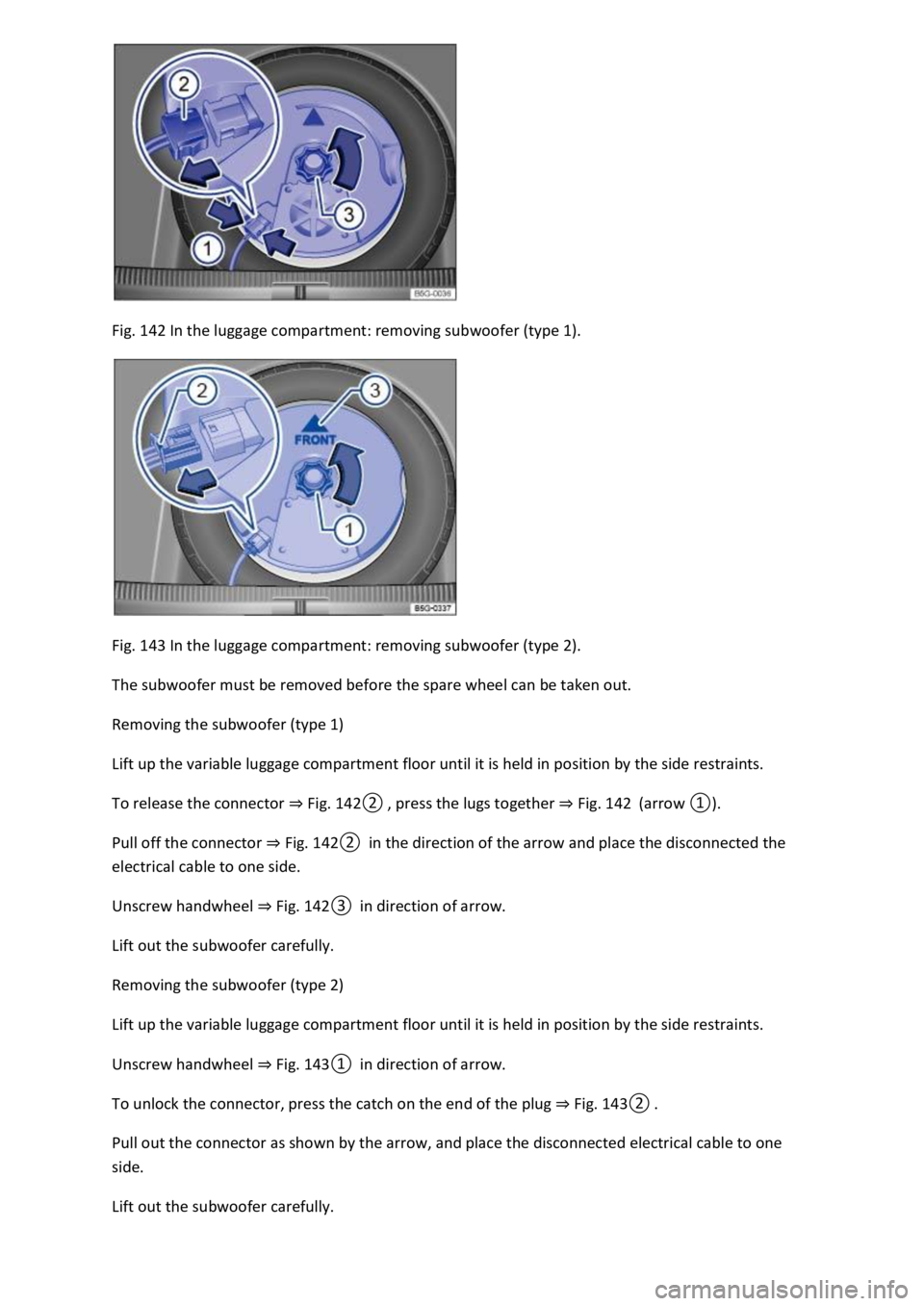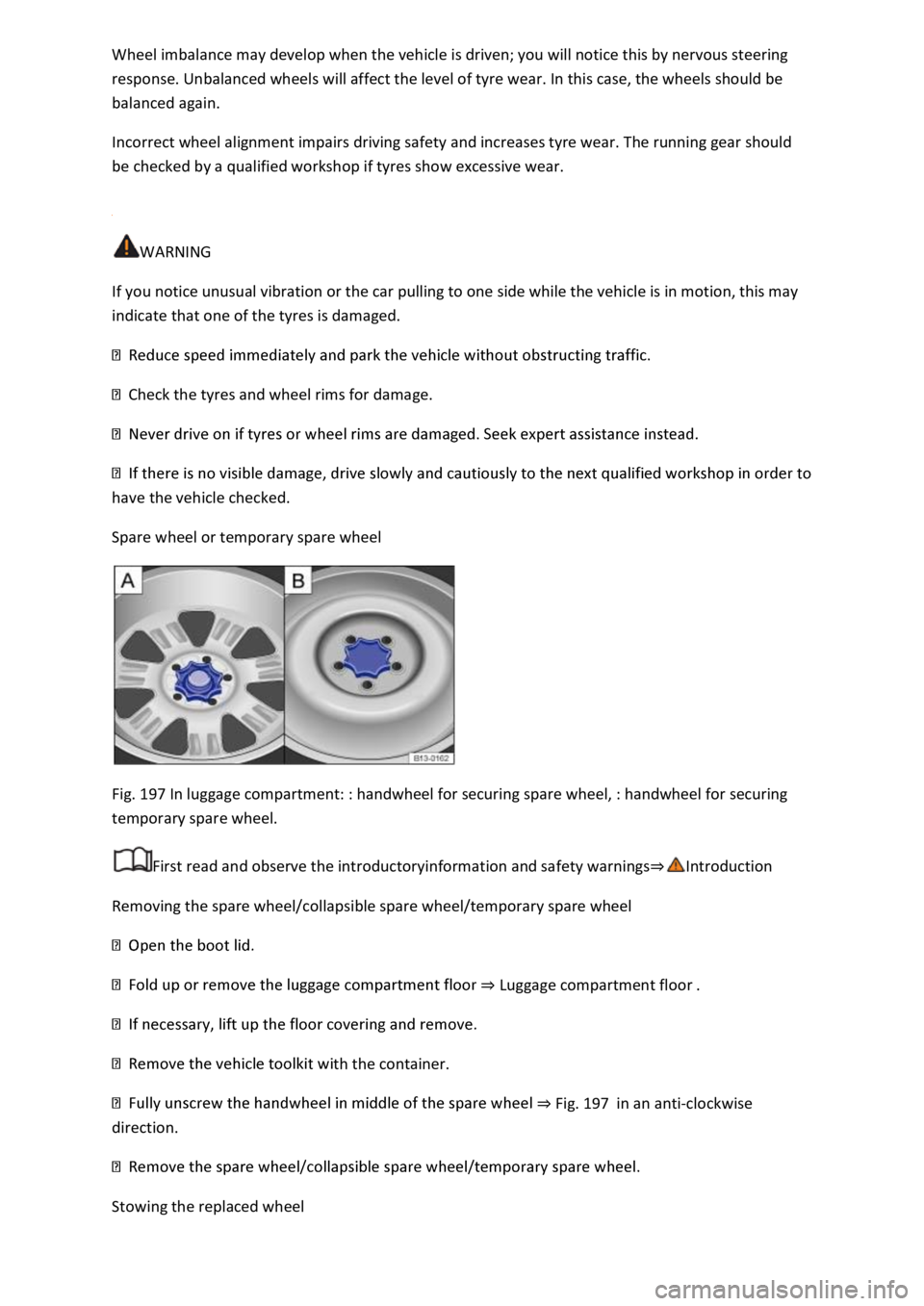2018 VOLKSWAGEN T-ROC spare wheel
[x] Cancel search: spare wheelPage 220 of 502

To ensure your own safety and the safety of your passengers, observe the following points before
driving offroad:
Obtain sufficient information before driving into offroad terrain with the vehicle.
Do not plan day stages that are too long. Take increased fuel consumption for offroad driving into
account.
Fill up the tank. Fuel consumption is considerably higher offroad.
Check that your tyres are suitable for the offroad journey you have planned. Recommendation for
difficult offroad terrain: always have offroad tyres fitted to your vehicle.
Check the tyre pressure on all tyres and correct if necessary. This includes the temporary spare
wheel, if present.
Check engine oil level and refill engine oil as necessary. The engine will be supplied with engine oil
when it is driven on or across a slope only if the engine oil level is sufficient.
Completely refill the washer fluid reservoir with water and washer fluid.
Fit the towing eye at the front or rear. It is not always possible to fit the towing eye when the vehicle
is stuck.
Check the vehicle toolkit and add tools according to individual requirements Useful accessories for
offroad driving.
Stow luggage in the vehicle as evenly and as low as possible. Secure all loose items.
Before driving offroad, Volkswagen recommends attending an offroad driving course, particularly if
you have no or very little experience.
Page 222 of 502

ot on the clutch when driving offroad. When travelling over
uneven ground, you could press the clutch by mistake and lose control of the vehicle. This also
prevents power being transferred between the engine and the gearbox. In addition, driving with the
clutch partially engaged causes premature wear to the clutch lining.
Useful accessories for offroad driving
First read and observe the introductoryinformation and safety warnings
The checklist contains just a few items of equipment that can be very useful for offroad driving. If
you have an instruction manual or fitting instructions for these accessories, you should always take
them with you and observe them as necessary when driving offroad.
Checklist
Useful items when driving offroad:
Water, compass, maps and torch with spare batteries.
Winch, tow bar or rope with sufficient strength.
Mobile telephone, shovel, blankets and rubber boots.
Electrical air compressor for connection to the 12-volt sockets in the vehicle to inflate the tyres.
A wooden board approx. 4 cm thick and approx. 1 metre long or an aluminium frame of similar size:
this can be used to free a vehicle stuck in the mud and provide a platform for a vehicle jack.
Snow chains, additional spare wheels, a breakdown set, jack and box spanner.
Changing gear correctly
First read and observe the introductoryinformation and safety warnings
The correct choice of gear depends on the offroad terrain.
Before attempting to drive through difficult terrain it can be helpful to stop and consider which gear
you should select. After several trips offroad, you will learn which gear to select in conjunction with
the step-down ratio and differential locks for different types of terrain.
General rules
Page 291 of 502

Fig. 142 In the luggage compartment: removing subwoofer (type 1).
Fig. 143 In the luggage compartment: removing subwoofer (type 2).
The subwoofer must be removed before the spare wheel can be taken out.
Removing the subwoofer (type 1)
Lift up the variable luggage compartment floor until it is held in position by the side restraints.
To release the connector Fig.
0Fig. 142
Pull off the connector Fig.
0in the direction of the arrow and place the disconnected the
electrical cable to one side.
Unscrew handwheel Fig.
0in direction of arrow.
Lift out the subwoofer carefully.
Removing the subwoofer (type 2)
Lift up the variable luggage compartment floor until it is held in position by the side restraints.
Unscrew handwheel Fig.
0in direction of arrow.
To unlock the connector, press the catch on the end of the plug Fig.
0
Pull out the connector as shown by the arrow, and place the disconnected electrical cable to one
side.
Lift out the subwoofer carefully.
Page 333 of 502

The yellow catalytic converter lamp lights up or flashes.
Faults in the exhaust system caused by misfiring, which can damage the catalytic converter.
to the nearest qualified workshop immediately.
There may be engine faults and fuel consumption may be higher if the indicator lamps are lit up or
flashing.
If and when
Vehicle toolkit
Introduction
This chapter contains information on the followingsubjects:
Stowage
Vehicle toolkit contents
Observe any country-specific legislation when securing your vehicle in the event of a breakdown.
Vehicle toolkit in the vehicle
In vehicles that are factory-fitted with a spare wheel, emergency spare wheel or winter wheels,
additional vehicle tools may be located in the luggage compartment.
WARNING
In the event of a sudden driving or braking manoeuvre or accident, a loose vehicle toolkit,
breakdown set and spare wheel or temporary spare wheel could be flung though the vehicle and
cause severe injuries.
always secured in the luggage compartment.
WARNING
Unsuitable or damaged tools in the vehicle toolkit can lead to accidents and injuries.
Stowage
Page 395 of 502

Tyre Pressure Loss Indicator. In the event of a malfunction, the indicator lamp will flash for 65
seconds and then light up continuously. However, the indicator lamp will go out when the road
conditions or driving style change.
Useful information about wheels and tyres
Introduction
This chapter contains information on the followingsubjects:
Handling wheels and tyres
Wheel rims and wheel bolts
Tyre pressure
Tread depth and wear indicators
Tyre damage
Spare wheel or temporary spare wheel
Tyre lettering and tyre type
Maximum load and speed range for tyres
Winter tyres
Snow chains
The tyres are the most heavily loaded and most underestimated parts of a vehicle. Tyres are very
important as the narrow tyre contact surfaces are the only contact between the vehicle and the
road.
The service life of tyres is dependent on tyre pressure, driving style, handling and correct fitting.
WARNING
New tyres or tyres which are old, worn down or damaged cannot provide full vehicle control and
braking efficiency.
injuries.
s must be fitted with radial tyres of the same type, size (rolling circumference) and
the same tread pattern.
particularly carefully for the first 600 km in order to prevent accidents and serious injury.
the tyre pressure is too low, it is possible that the tyre temperature will increase to such an extent
when driving that the tread peels off and the tyre bursts.
Page 401 of 502

Information on the sticker Fig. 194
Tyre pressure for the tyres on the front axle.
Tyre pressure for the tyres on the rear axle.
Note: check the tyre pressure when the tyres are cold.
Tyre pressure for partial load.
Vehicle-dependent: comfort tyre pressure for partial load.
Tyre pressure for full load.
Tyre pressure level for the spare or temporary spare wheel.
The sticker provides the correct tyre pressure for approved tyres and is located either on the driver
door pillar Fig. 195or inside the tank flap.
The appearance of the sticker may differ between vehicles. It may include additional tyre sizes.
The wrong tyre pressure will have a negative effect on the vehicle handling and leads to high levels
of wear or even a burst tyre at high speeds.
Comfort tyre pressure
Depending on the vehicle, the tyre pressure sticker may show details of a comfort tyre pressure
Fig.
0
increase when driving with comfort tyre pressure.
Checking the tyre pressure
tyres. Tyre pressure is always higher in warm tyres than it is in cold tyres. For this reason, never
reduce the pressure in warm tyres to adjust the tyre pressure.
Fig.
0
and observe the
information on the tyre monitoring system.
which is given on the sidewall of the tyre.
WARNING
Page 404 of 502

response. Unbalanced wheels will affect the level of tyre wear. In this case, the wheels should be
balanced again.
Incorrect wheel alignment impairs driving safety and increases tyre wear. The running gear should
be checked by a qualified workshop if tyres show excessive wear.
WARNING
If you notice unusual vibration or the car pulling to one side while the vehicle is in motion, this may
indicate that one of the tyres is damaged.
Check the tyres and wheel rims for damage.
have the vehicle checked.
Spare wheel or temporary spare wheel
Fig. 197 In luggage compartment: : handwheel for securing spare wheel, : handwheel for securing
temporary spare wheel.
First read and observe the introductoryinformation and safety warnings
Removing the spare wheel/collapsible spare wheel/temporary spare wheel
Luggage compartment floor
th the container.
Fig. 197in an anti-clockwise
direction.
Stowing the replaced wheel
Page 405 of 502

r remove the luggage compartment floor Luggage compartment floor
centre hole in the rim is positioned exactly above the hole or threaded pin.
overing in the luggage compartment if necessary.
Luggage compartment floor
If the spare wheel tyre is not the same as the tyres on the vehicle
If the spare wheel tyre differs from the other tyres on the vehicle, the spare wheel must be used
only in the event of a tyre failure and for a short time
Observe these driving notes:
km/h (50 mph).
not use snow chains on the temporary spare wheel Snow chains
spare wheel Tyre pressure
WARNING
Incorrect use of the spare wheel or temporary spare wheel can lead to a loss of control over the
vehicle, collisions or other accidents and cause serious injuries.
wear indicators.
ped with a temporary spare wheel instead of a spare wheel. The
temporary spare wheel can be recognised by a sticker and the text 80 km/h or 50 mph. This is the
maximum speed at which you are permitted to drive with this tyre. The sticker must not be covered
during use of the wheel.
km/h (50 mph. Do not accelerate quickly, brake suddenly or drive at
high speed through bends.
km with a temporary spare wheel if it is fitted to the drive axle.